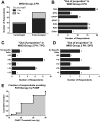Use of pulmonary arterial hypertension-approved therapy in the treatment of non-group 1 pulmonary hypertension at US referral centers
- PMID: 26064462
- PMCID: PMC4449248
- DOI: 10.1086/681264
Use of pulmonary arterial hypertension-approved therapy in the treatment of non-group 1 pulmonary hypertension at US referral centers
Abstract
Pulmonary hypertension (PH) is a frequent complication of left heart disease and parenchymal lung disease, and it portends increased mortality. A growing number of medications are approved for the treatment of World Health Organization (WHO) group 1 pulmonary arterial hypertension (PAH). However, they are not well studied in PH of other etiologies (WHO groups 2-5). We sought to assess treatment approaches used by PAH referral centers in this diverse group of patients. We developed a semiquantitative online survey designed to evaluate the use of PAH-approved therapy by pulmonary vascular disease centers in the United States for management of non-group 1 PH. Thirty of 50 centers completed the survey. Almost all centers (93%) reported using PAH therapy for patients with non-group 1 PH, including 77% with group 2 PH and 80% with group 3 PH. Elevated transpulmonary gradient or pulmonary vascular resistance and the presence of right ventricular (RV) dysfunction were commonly cited as supporting use of PAH therapy in patients with PH secondary to left heart disease. For patients with PH and concomitant parenchymal lung disease, degree of pulmonary function impairment and RV dysfunction were most important in influencing use of PAH therapy. In conclusion, pulmonary vascular disease treatment centers use PAH-approved therapy for patients with WHO group 2-5 PH, mostly relying on hemodynamics and assessment of RV function to identify candidates for therapy. Clinical trials designed to test the efficacy of PAH therapy in PH due to left heart and lung disease are needed, as clinical practice has extended beyond the evidence for these etiologies of PH.
Keywords: chronic obstructive pulmonary disease; heart failure; restrictive lung disease; survey.
Figures




Similar articles
-
The Challenge to Decide between Pulmonary Hypertension Due to Chronic Lung Disease and PAH with Chronic Lung Disease.Diagnostics (Basel). 2021 Feb 15;11(2):311. doi: 10.3390/diagnostics11020311. Diagnostics (Basel). 2021. PMID: 33671914 Free PMC article.
-
Why there is a need to discuss pulmonary hypertension other than pulmonary arterial hypertension?World J Crit Care Med. 2015 Nov 4;4(4):274-7. doi: 10.5492/wjccm.v4.i4.274. eCollection 2015 Nov 4. World J Crit Care Med. 2015. PMID: 26557477 Free PMC article.
-
Contribution of Impaired Parasympathetic Activity to Right Ventricular Dysfunction and Pulmonary Vascular Remodeling in Pulmonary Arterial Hypertension.Circulation. 2018 Feb 27;137(9):910-924. doi: 10.1161/CIRCULATIONAHA.117.027451. Epub 2017 Nov 22. Circulation. 2018. PMID: 29167228
-
Diagnosis, assessment, and treatment of non-pulmonary arterial hypertension pulmonary hypertension.J Am Coll Cardiol. 2009 Jun 30;54(1 Suppl):S85-S96. doi: 10.1016/j.jacc.2009.04.008. J Am Coll Cardiol. 2009. PMID: 19555862 Review.
-
Right heart adaptation to pulmonary arterial hypertension: physiology and pathobiology.J Am Coll Cardiol. 2013 Dec 24;62(25 Suppl):D22-33. doi: 10.1016/j.jacc.2013.10.027. J Am Coll Cardiol. 2013. PMID: 24355638 Review.
Cited by
-
Mortality in US veterans with pulmonary hypertension: a retrospective analysis of survival by subtype and baseline factors.Pulm Circ. 2019 Jan-Mar;9(1):2045894019825763. doi: 10.1177/2045894019825763. Pulm Circ. 2019. PMID: 30638433 Free PMC article.
-
Pulmonary hypertension-targeted therapies in heart failure: A systematic review and meta-analysis.PLoS One. 2018 Oct 11;13(10):e0204610. doi: 10.1371/journal.pone.0204610. eCollection 2018. PLoS One. 2018. PMID: 30307953 Free PMC article.
-
Practice patterns of pulmonary hypertension secondary to left heart disease among pediatric pulmonary hypertension providers.Pulm Circ. 2021 Feb 9;11(1):2045894021991446. doi: 10.1177/2045894021991446. eCollection 2021 Jan-Mar. Pulm Circ. 2021. PMID: 33623667 Free PMC article.
-
The incremental shuttle walk test predicts mortality in non-group 1 pulmonary hypertension: results from the ASPIRE Registry.Pulm Circ. 2019 Apr-Jun;9(2):2045894019848649. doi: 10.1177/2045894019848649. Pulm Circ. 2019. PMID: 30997865 Free PMC article.
-
Pulmonary hypertension due to interstitial lung disease or chronic obstructive pulmonary disease: a patient experience study of symptoms and their impact on quality of life.Pulm Circ. 2021 Apr 1;11(2):20458940211005641. doi: 10.1177/20458940211005641. eCollection 2021 Apr-Jun. Pulm Circ. 2021. PMID: 33868642 Free PMC article.
References
-
- Simonneau G, Gatzoulis MA, Adatia I, et al. Updated clinical classification of pulmonary hypertension. J Am Coll Cardiol 2013;62:D34–D41. - PubMed
-
- Hoeper MM, Bogaard HJ, Condliffe R, et al. Definitions and diagnosis of pulmonary hypertension. J Am Coll Cardiol 2013;62:D42–D50. - PubMed
-
- Galiè N, Corris PA, Frost A, et al. Updated treatment algorithm of pulmonary arterial hypertension. J Am Coll Cardiol 2013;62:D60–D72. - PubMed
-
- Oudiz RJ. Pulmonary hypertension associated with left-sided heart disease. Clin Chest Med 2007;28:233–241. - PubMed
Grants and funding
LinkOut - more resources
Full Text Sources
Other Literature Sources

